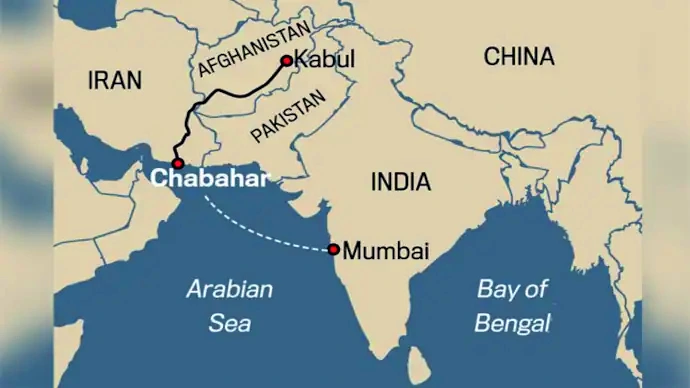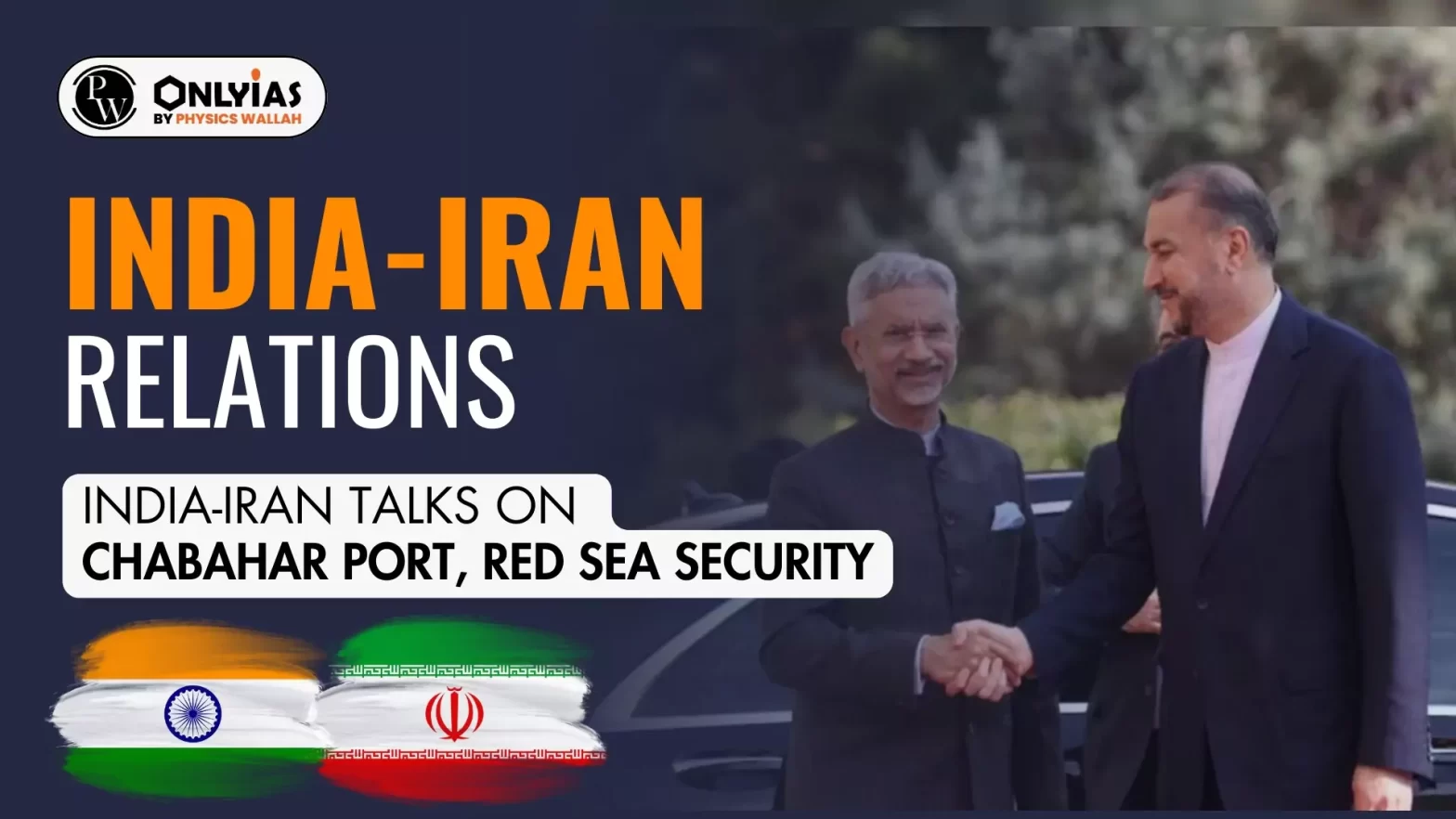Context:
This article is based on the news “Jaishankar in Iran, discusses Chabahar Port, Red Sea attacks” which was published in the Indian Express. The External Affairs Minister of India visited Iran during the ongoing high-level exchanges between the two sides.
India-Iran Relations: High-Level Talks On Chabahar Port, and Red Sea Concerns
- Maritime Security Concern: Addressed concern about threats to maritime shipping in the region.
- Red Sea Crisis: Highlighted attacks by Houthi militants targeting merchant vessels in the Red Sea amid the Israel-Hamas conflict.
- Chabahar Port Development Plan: An agreement between India and Iran on further developing the Chabahar Port was signed.
- The new long-term agreement will replace the original contract which only covered India’s operations at the Shahid Beheshti terminal in the Chabahar port and was renewed yearly.
- The new agreement has a validity of ten years and will be automatically extended.
- Proposal for Joint Transportation Committee: It will help to expand cooperation between the two countries.
- The committee will enable the activation of transit capacities and the use of the North-South corridor.
- Humanitarian Focus on Gaza Situation: India expressed concern about the deeply concerning situation in Gaza, focusing on the loss of civilian lives, especially women and children.
- Other Areas Of Discussion: Both sides also discussed the importance of the common view of the two countries in the field of combating terrorism and organized crime; the need for cooperation to establish stability and security in Afghanistan; strengthening international trade, especially through national currencies;
Also Refer: UN Resolution Calling for ‘Humanitarian Pauses’ in Gaza
About Chabahar Port
- It is located in Sistan-Balochistan province on Iran’s southern coast, developed jointly by India and Iran to boost connectivity and trade ties.
- India has been advocating for the port project to enhance regional trade, particularly to improve connectivity with Afghanistan.
- The port is also considered a crucial hub for implementing the International North-South Transport Corridor (INSTC) project.

Significance of Chabhar Port
- It is vital for both India and Iran as it reduces their dependence on the Suez Canal for transporting cargo to Europe.
- It provides a link between India and Afghanistan without going through Pakistan.
- It provides an Indian strategic counter to Pakistan’s Gwadar port being developed by China.
Continue To Read: Chabahar Port Project – Why It Significant To India?
About INSTC Project
- The INSTC project is a 7,200-km-long multimode transport project for moving freight between India, Iran, Afghanistan, Armenia, Azerbaijan, Russia, Central Asia and Europe.
- India had pledged to invest $85 million in the terminal and provided cranes and other equipment worth a few million dollars.
|
Must Read: How Are Houthi Attacks On Ships In The Red Sea Affecting Global Economy?
About India-Iran Relations: Historical, Political, Economic and Cultural
- Historical Relation: The India-Iran relations can be traced back to the ancient times of Indus Valley civilization. There was trade between the coast of southern Iran and India through the Persian Gulf and the Arabian Sea.
- Political Dimension: India and Iran signed a friendship treaty on 15 March 1950.
- The Tehran Declaration signed between the two countries affirms the two countries’ shared vision for an “equitable, pluralistic and co-operative international order.”
- Geo Strategic Location: Iran’s unique geographical position provides India access to Central Asia, Afghanistan, and Eurasia markets.
- India and Iran share a common strategic objective of regional stability in southwest Asia.
- India abstained during the recent voting on the resolution by the US and its allies to censure Iran at the IAEA.
- Economic Ties: Bilateral trade between Iran and India was US$2.5 billion in 2022, reflecting an increase of 48 percent compared to US$1.693 billion in 2021.
- In 2022, the export of Iranian oil products to India was US$175 million.
- In July 2022, the Reserve Bank of India (RBI) launched a system for settling, billing, and paying exports and imports in Indian Rupees (INR).
- Other Major Indian Exports: Sugar, manmade staple fibers, electrical machinery and artificial jewelry.
- Indian Imports from Iran: Dry fruits, chemicals and glassware.
- Iran recently included India in the list of countries whose citizens will not require a visa to travel to Iran.
- Energy Security: Iran ranks second globally in terms of gas reserves presenting opportunities for fuel diversification, decarbonization, and increasing the share of gas in India’s energy mix until 2030.
- Cultural Ties: Civilizational links between India and Iran are the source of robust people-to-people and cultural ties.
- The Indian Cultural Centre was established in 2013 and renamed the Swami Vivekananda Cultural Centre (SVCC) in 2018.
- India recently decided to include Farsi (Persian) as one of the nine classical languages in India under the New Education Policy.
India-Iran Relations: Recent Challenges
- US Sanctions impacting India’s Oil Imports and Chabahar Project: India ceased to import Iranian oil on account of US sanctions on Tehran and its withdrawal from the Iran nuclear deal,
- This also impacted the Chabahar project although the project was exempt from sanctions.
- US sanctions have impacted Iranian oil exports and hindered Indo-Iranian cooperation on the development of Iran’s southeastern Chabahar Port.
- China’s Increasing Presence: China has strengthened its relations with Iran by signing a 25-year comprehensive cooperation agreement.
- It has been consistently purchasing Iranian oil despite U.S. sanctions. China’s plan to expand its maritime trade network and gain access to shipping routes has created a clash with India’s aspirations.
- Israeli Factor: India has close ties with Israel and it presents a challenge for India to balance its relations with Iran.
- Israel has strained relations with Iran and due to the existing ties between India and Iran, Israel has raised concerns about the potential transfer of military equipment or technology from India to Tehran.
- Security Concerns: Hamas, Hezbollah and Houthis rebel groups are supported by Iran.
- The Houthi militia has been using Kamikaze drones, missiles and other weapons against commercial shipping in the Red Sea and Arabian Sea.
- Recently, Iranian ammunition targeted a tanker called MV Camp Plato off the coast of Dwarka creating challenges for maritime shipping for India.
- Afghanistan Issue: The US withdrawal from Afghanistan created challenges for India’s Afghan strategy which relied on US-Iran cooperation for its Afghan interests.
Way Forward to the India-Iran Relations
- Ensuring Energy Security: India should take the lead in establishing an institutional framework and advance the Turkmenistan–Afghanistan–Pakistan–India (TAPI) gas pipeline project to guarantee energy security.
- A long-term supply agreement on natural gas cooperation out of US unilateral sanctions may be finalized.
- Enhancing Trade: India needs to decrease the tariffs on Iranian agricultural goods through Preferential trade Agreements to enhance bilateral commercial ties through special economic mechanisms like signing preferential trade agreements.
- An agreement similar to the 25-year investment deal signed between China and Iran may be signed.
- Infrastructure Cooperation: India’s investment in Iranian oil and petrochemicals, the development of sea lines and the export of technical and engineering services will lead to expanding trade between the two nations.
- Development of offshore gas fields like Farzad B and the fertilizer industries hold potential for cooperation between India and Iran.
- Indian small and medium-sized enterprises (SMEs) can invest in Chabahar Economic Free Zone (EFZ) to set up petrochemical and fertilizer plants either independently or through joint ventures with Iranian public-private companies.
- Curbing Terrorism: Both nations need to cooperate to fight terrorism and to create peace, stability, and security in the region.
- This is necessary, especially regarding the Pak-Afghan region as the epicenter of international terrorism.
- Boosting Connectivity: India and Iran should promote joint efforts with the Russian Federation and other Central Asia and Caucasus countries to upgrade existing transport corridors, especially the International North-South Transport Corridor (INSTC).
- Enhancing Regional Cooperation through Multilateral Forums: India can utilize BRICS and Shanghai Cooperation Organization (SCO) platforms to discuss important regional issues with the region.
- The Ex-Chabahar Port project was stalled for years due to US sanctions as well as the Issue of peace and stability in Afghanistan.
![]() 16 Jan 2024
16 Jan 2024

